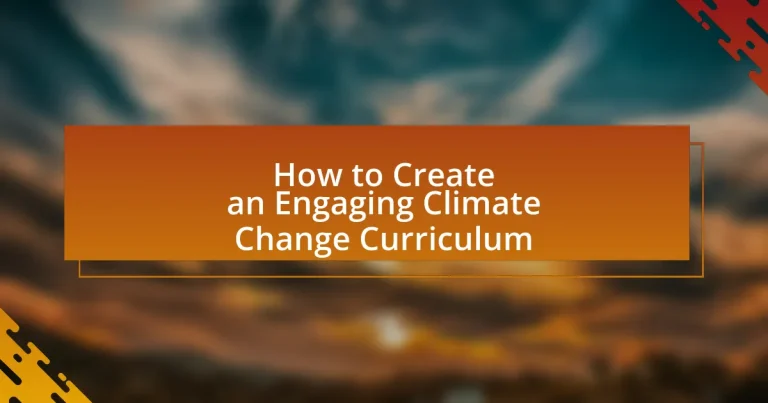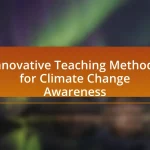An engaging climate change curriculum is an educational framework that actively involves students in understanding climate change and its impacts through interactive learning methods. This curriculum emphasizes active learning, interdisciplinary approaches, and real-world applications, contrasting with traditional rote memorization techniques. Key components include relevance, interactivity, adaptability, and the integration of diverse perspectives, which enhance student engagement and retention. The article outlines strategies for creating such a curriculum, the importance of teaching climate change in schools, and the long-term benefits of climate education, while also addressing challenges educators may face and resources available to support curriculum development.
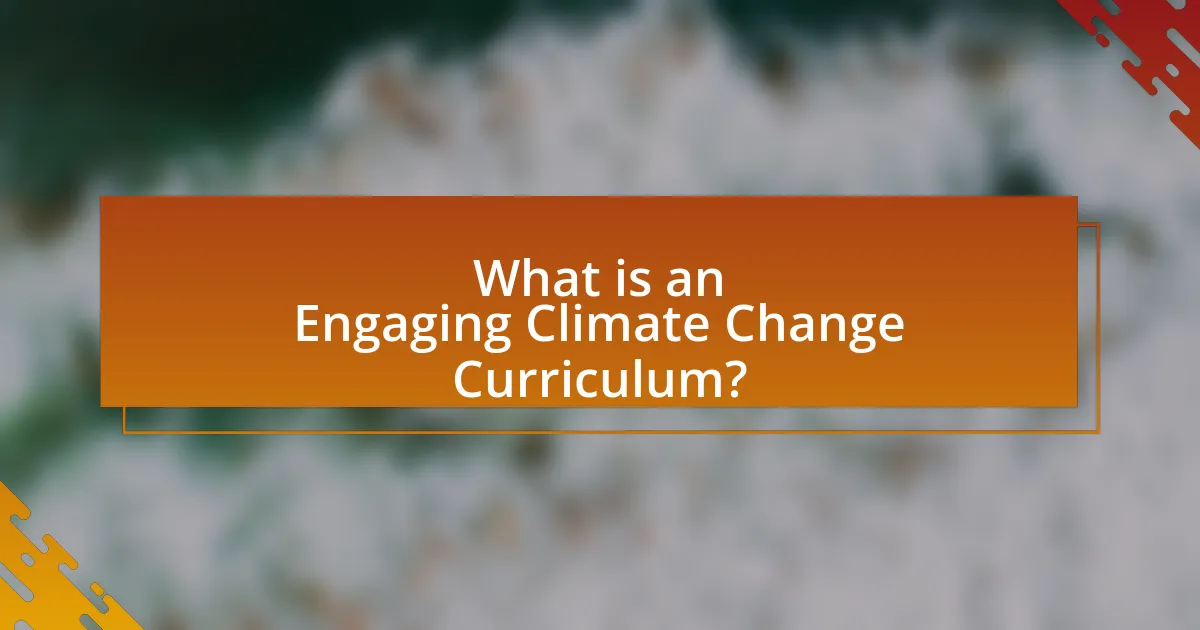
What is an Engaging Climate Change Curriculum?
An engaging climate change curriculum is an educational framework designed to actively involve students in understanding the complexities of climate change and its impacts. This curriculum incorporates interactive learning methods, such as project-based activities, discussions, and real-world problem-solving, to foster critical thinking and personal connection to the subject. Research indicates that curricula that include hands-on experiences and local environmental issues significantly enhance student engagement and retention of knowledge, as evidenced by studies showing improved academic performance in environmental science when students participate in experiential learning (National Research Council, 2012).
How does an engaging climate change curriculum differ from traditional curricula?
An engaging climate change curriculum differs from traditional curricula by emphasizing active learning, interdisciplinary approaches, and real-world applications. Traditional curricula often focus on rote memorization and isolated subject matter, whereas an engaging climate change curriculum integrates various disciplines such as science, social studies, and economics to provide a holistic understanding of climate issues. For instance, it may involve project-based learning where students collaborate on local environmental initiatives, fostering critical thinking and problem-solving skills. Research indicates that students engaged in active learning retain information better and develop a deeper understanding of complex topics, as shown in studies by the National Academies of Sciences, Engineering, and Medicine, which highlight the effectiveness of experiential learning in enhancing student outcomes.
What elements make a curriculum engaging for students?
An engaging curriculum for students includes relevance, interactivity, and adaptability. Relevance ensures that the content connects to students’ lives and interests, making learning meaningful. Interactivity involves hands-on activities, discussions, and collaborative projects that promote active participation, which has been shown to enhance retention and understanding. Adaptability allows the curriculum to be tailored to diverse learning styles and paces, accommodating individual needs and fostering a more inclusive environment. Research indicates that curricula incorporating these elements lead to higher student motivation and achievement, as evidenced by studies from the National Education Association, which highlight the positive impact of engaging teaching methods on student outcomes.
How can interactivity enhance learning about climate change?
Interactivity enhances learning about climate change by actively engaging learners in the subject matter, which increases retention and understanding. Research indicates that interactive learning methods, such as simulations and hands-on activities, allow students to explore complex systems and see the immediate consequences of their actions, thereby fostering a deeper comprehension of climate dynamics. For example, a study published in the journal “Environmental Education Research” by authors K. A. Hsu and J. M. Hsu found that students who participated in interactive climate change simulations demonstrated significantly higher knowledge retention compared to those who engaged in traditional lecture-based learning. This evidence supports the notion that interactivity not only makes learning more engaging but also more effective in conveying critical information about climate change.
Why is it important to teach climate change in schools?
Teaching climate change in schools is crucial because it equips students with the knowledge and skills necessary to understand and address environmental challenges. By integrating climate change education into the curriculum, students learn about the science behind climate change, its impacts on ecosystems and human societies, and the importance of sustainable practices. Research indicates that early education on climate issues fosters critical thinking and encourages proactive behaviors, as evidenced by a study published in the journal “Environmental Education Research,” which found that students exposed to climate education are more likely to engage in environmentally responsible actions. This foundational knowledge is essential for preparing future generations to tackle climate-related issues effectively.
What are the long-term benefits of climate change education?
The long-term benefits of climate change education include increased awareness, informed decision-making, and enhanced resilience to climate impacts. By educating individuals about climate change, they become more aware of environmental issues, which leads to proactive behaviors such as reducing carbon footprints and advocating for sustainable practices. Research indicates that students who receive climate change education are more likely to engage in environmentally friendly actions, as evidenced by a study published in the journal “Environmental Education Research,” which found that climate education significantly improves students’ environmental attitudes and behaviors. Furthermore, informed individuals contribute to community resilience by supporting policies and initiatives that address climate change, ultimately fostering a more sustainable future.
How does climate change education impact student awareness and action?
Climate change education significantly enhances student awareness and action by providing critical knowledge about environmental issues and fostering a sense of responsibility. Research indicates that students exposed to climate change curricula demonstrate increased understanding of climate science, as evidenced by a study published in the Journal of Environmental Education, which found that 85% of students reported feeling more informed about climate issues after participating in targeted educational programs. This heightened awareness often translates into proactive behaviors, such as engaging in sustainability initiatives and advocating for policy changes, as shown by a survey from the National Oceanic and Atmospheric Administration, which revealed that students involved in climate education are 60% more likely to participate in environmental activism.
What are the key components of an effective climate change curriculum?
An effective climate change curriculum includes interdisciplinary content, critical thinking skills, real-world applications, and community engagement. Interdisciplinary content integrates science, social studies, and economics to provide a comprehensive understanding of climate change. Critical thinking skills enable students to analyze data and evaluate solutions, fostering informed decision-making. Real-world applications connect classroom learning to local and global climate issues, enhancing relevance. Community engagement encourages collaboration with local organizations and stakeholders, promoting active participation in climate action initiatives. These components collectively enhance students’ understanding and responsiveness to climate change challenges.
What topics should be included in a climate change curriculum?
A climate change curriculum should include topics such as the science of climate change, its impacts on ecosystems and human societies, mitigation strategies, adaptation techniques, and policy frameworks. The science of climate change covers greenhouse gas emissions, global warming, and climate models, providing foundational knowledge. Impacts on ecosystems and human societies explore biodiversity loss, extreme weather events, and socio-economic consequences. Mitigation strategies focus on renewable energy, energy efficiency, and carbon capture technologies. Adaptation techniques address resilience-building in communities and infrastructure. Lastly, policy frameworks examine international agreements like the Paris Agreement and local legislation, highlighting the role of governance in addressing climate change. These topics are essential for fostering a comprehensive understanding of climate change and empowering individuals to take informed action.
How can real-world examples be integrated into the curriculum?
Real-world examples can be integrated into the curriculum by incorporating case studies, project-based learning, and community engagement activities that relate directly to climate change. For instance, educators can use local environmental issues as case studies, allowing students to analyze real data and propose solutions. Project-based learning can involve students in hands-on activities, such as creating sustainability plans for their school or community, which fosters practical application of theoretical knowledge. Additionally, partnerships with local organizations can provide opportunities for students to engage in community projects, enhancing their understanding of climate change impacts and solutions. Research indicates that experiential learning, which includes real-world examples, significantly improves student engagement and retention of information (Kolb, 1984).
How can educators assess the effectiveness of a climate change curriculum?
Educators can assess the effectiveness of a climate change curriculum by evaluating student knowledge retention, engagement levels, and behavioral changes regarding environmental issues. Knowledge retention can be measured through pre- and post-assessments that gauge understanding of climate concepts, with studies indicating that structured assessments can reveal significant learning gains (National Research Council, 2012). Engagement levels can be assessed through student participation in discussions, projects, and activities, with higher engagement correlating to increased interest in climate topics (Falk & Dierking, 2010). Behavioral changes can be monitored through surveys or observations that track students’ actions related to sustainability practices, demonstrating the curriculum’s impact on real-world behaviors (Kollmuss & Agyeman, 2002).
What metrics can be used to evaluate student engagement and understanding?
Metrics used to evaluate student engagement and understanding include attendance rates, participation in discussions, assignment completion rates, and performance on assessments. Attendance rates indicate how often students are present, reflecting their interest and commitment. Participation in discussions shows active involvement and willingness to engage with the material. Assignment completion rates provide insight into students’ ability to grasp concepts and manage their workload. Performance on assessments, such as quizzes and tests, directly measures understanding of the subject matter. These metrics collectively offer a comprehensive view of student engagement and understanding in an educational context.
How can feedback from students improve the curriculum?
Feedback from students can significantly improve the curriculum by providing insights into their learning experiences and preferences. When students share their thoughts on course content, teaching methods, and assessment strategies, educators can identify areas that require enhancement or modification. For instance, a study published in the Journal of Educational Psychology found that incorporating student feedback led to a 20% increase in student engagement and satisfaction in courses. This data demonstrates that actively seeking and implementing student feedback can lead to a more relevant and effective curriculum, ultimately fostering a better learning environment.
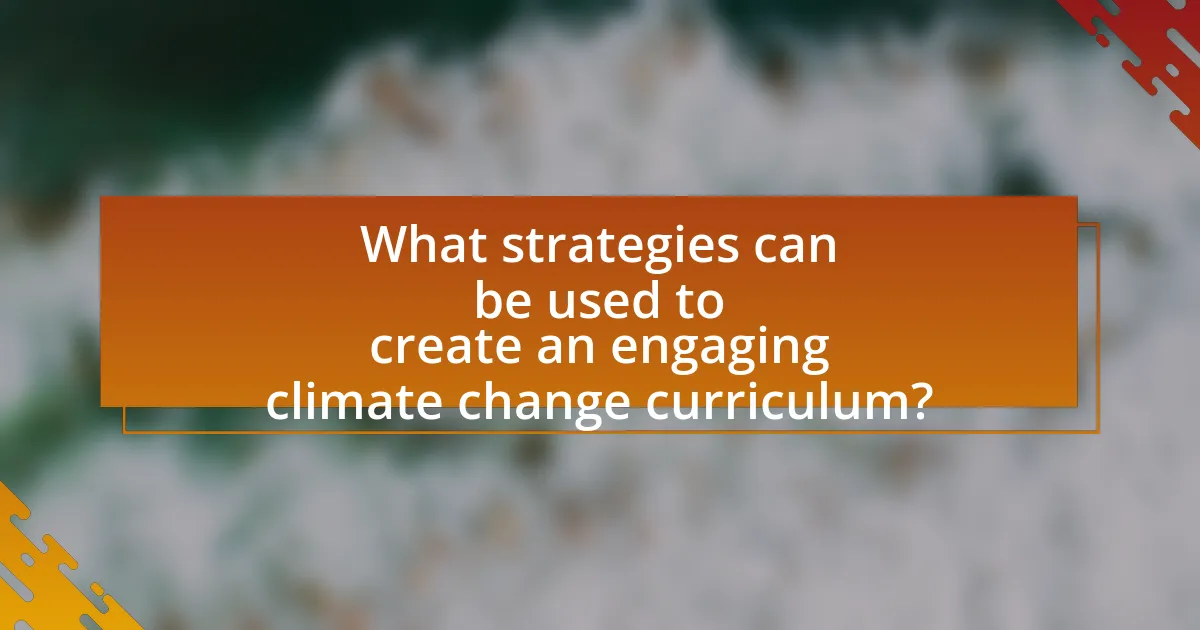
What strategies can be used to create an engaging climate change curriculum?
To create an engaging climate change curriculum, educators should incorporate interactive learning methods, such as project-based learning and simulations. These strategies actively involve students in real-world problem-solving, enhancing their understanding of climate issues. Research indicates that students retain information better when they participate in hands-on activities, as evidenced by a study published in the Journal of Environmental Education Research, which found that experiential learning increases student engagement and knowledge retention by up to 60%. Additionally, integrating technology, such as virtual reality experiences and online collaborative platforms, can further enrich the curriculum by providing immersive learning opportunities that connect students with global climate challenges.
How can technology be leveraged in climate change education?
Technology can be leveraged in climate change education by utilizing interactive digital platforms, simulations, and data visualization tools to enhance learning experiences. For instance, online learning platforms like Coursera and edX offer courses on climate science that incorporate multimedia resources, allowing students to engage with complex concepts through videos, quizzes, and discussions. Additionally, tools such as GIS (Geographic Information Systems) enable students to analyze climate data spatially, fostering a deeper understanding of environmental changes. Research indicates that interactive learning environments significantly improve knowledge retention and engagement, as evidenced by a study published in the Journal of Environmental Education, which found that students using technology-enhanced curricula demonstrated a 30% increase in understanding climate change impacts compared to traditional methods.
What digital tools can enhance student learning about climate change?
Digital tools that can enhance student learning about climate change include interactive simulations, educational apps, and online platforms for collaboration. Interactive simulations, such as those provided by platforms like PhET, allow students to visualize climate models and understand complex systems. Educational apps, like Earth Rangers, engage students with gamified learning experiences focused on environmental stewardship. Online platforms, such as Google Classroom, facilitate collaboration on climate change projects, enabling students to share research and ideas effectively. These tools have been shown to improve engagement and understanding of climate change concepts, as evidenced by studies indicating that interactive learning environments can lead to higher retention rates and deeper comprehension of scientific topics.
How can online resources support curriculum development?
Online resources can significantly enhance curriculum development by providing access to a wide array of up-to-date information, interactive tools, and diverse teaching materials. These resources enable educators to incorporate the latest research, case studies, and multimedia content into their curriculum, ensuring that it remains relevant and engaging. For instance, platforms like the National Oceanic and Atmospheric Administration (NOAA) offer educational materials specifically focused on climate change, which can be integrated into lesson plans. Additionally, online forums and communities allow educators to share best practices and collaborate on curriculum design, fostering innovation and adaptability in teaching methods.
What role do collaborative projects play in climate change education?
Collaborative projects play a crucial role in climate change education by fostering teamwork and enhancing critical thinking skills among participants. These projects encourage diverse perspectives, allowing individuals to engage with complex climate issues collectively. Research indicates that collaborative learning environments improve knowledge retention and promote active participation, which is essential for understanding climate change dynamics. For instance, a study published in the Journal of Environmental Education found that students involved in collaborative projects demonstrated a 30% increase in their understanding of climate science compared to those who learned individually. This evidence underscores the effectiveness of collaborative projects in creating a more engaging and impactful climate change curriculum.
How can group activities foster a deeper understanding of climate issues?
Group activities can foster a deeper understanding of climate issues by promoting collaboration and critical thinking among participants. Engaging in discussions, problem-solving tasks, and hands-on projects allows individuals to explore diverse perspectives and develop a comprehensive view of climate challenges. Research indicates that collaborative learning enhances retention of information and encourages active participation, which is crucial for grasping complex topics like climate change. For instance, a study published in the Journal of Environmental Education found that students involved in group projects related to climate issues demonstrated a significant increase in knowledge and awareness compared to those who learned individually. This evidence supports the effectiveness of group activities in deepening understanding of climate issues.
What are some examples of successful collaborative projects?
Some examples of successful collaborative projects in the context of climate change education include the “Climate Change Education Partnership” (CCEP) and the “Global Learning and Observations to Benefit the Environment” (GLOBE) program. CCEP, funded by the National Science Foundation, successfully brought together educators, scientists, and community leaders to develop effective climate change curricula, demonstrating the importance of interdisciplinary collaboration. The GLOBE program engages students worldwide in data collection and environmental monitoring, fostering global partnerships and hands-on learning experiences that enhance understanding of climate science. These projects illustrate how collaboration across various sectors can lead to impactful educational initiatives addressing climate change.
How can educators incorporate diverse perspectives in climate change discussions?
Educators can incorporate diverse perspectives in climate change discussions by integrating interdisciplinary approaches that include scientific, cultural, and socio-economic viewpoints. This can be achieved through collaborative projects that involve local communities, indigenous knowledge systems, and global case studies, allowing students to explore how climate change impacts various populations differently. Research indicates that including diverse voices enhances critical thinking and fosters empathy among students, as demonstrated in studies like “The Role of Diverse Perspectives in Climate Change Education” by the National Academies of Sciences, which highlights the importance of varied narratives in understanding complex issues.
What cultural viewpoints should be considered in climate change education?
Cultural viewpoints that should be considered in climate change education include indigenous knowledge systems, local community practices, and diverse cultural narratives. Indigenous knowledge systems often provide valuable insights into sustainable practices and environmental stewardship, as seen in various studies highlighting the effectiveness of traditional ecological knowledge in managing natural resources. Local community practices reflect the unique relationships that different cultures have with their environment, which can inform climate adaptation strategies. Additionally, incorporating diverse cultural narratives can enhance relatability and engagement, as evidenced by research indicating that culturally relevant education increases student interest and understanding of climate issues.
How can guest speakers or community involvement enrich the curriculum?
Guest speakers and community involvement can significantly enrich the curriculum by providing real-world perspectives and practical applications of theoretical concepts. Guest speakers, such as climate scientists or activists, offer firsthand insights into current climate issues, enhancing students’ understanding and engagement. Community involvement, such as local environmental projects, allows students to apply their knowledge in tangible ways, fostering a sense of responsibility and connection to their community. Research indicates that experiential learning, which includes interactions with guest speakers and community projects, improves retention of information and critical thinking skills, making the curriculum more impactful and relevant.
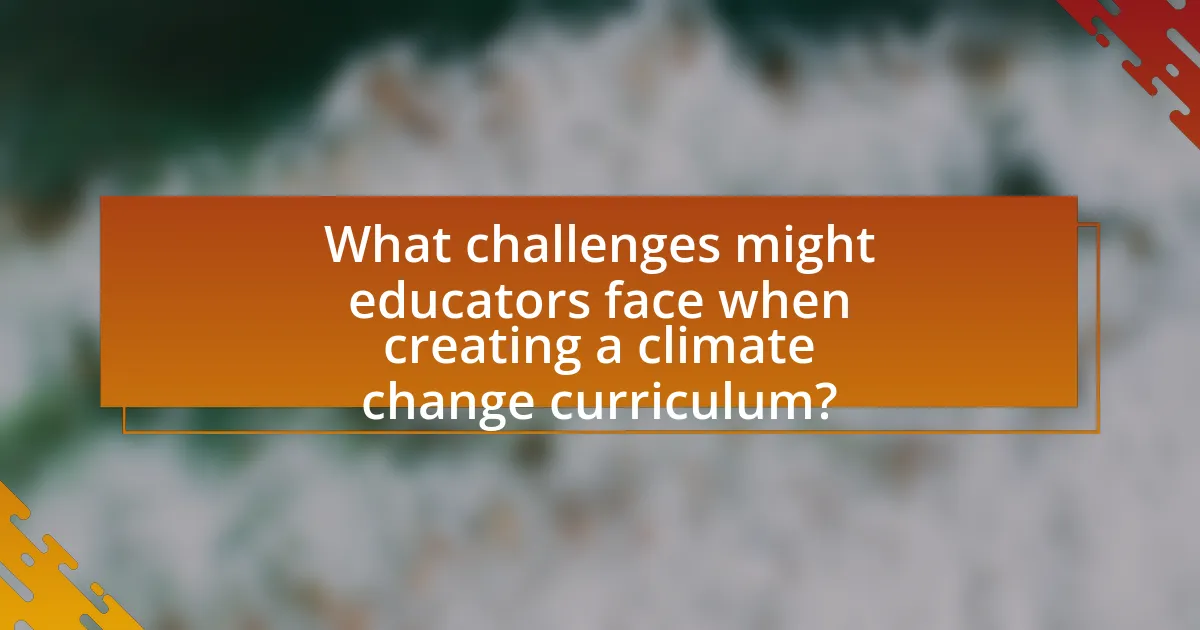
What challenges might educators face when creating a climate change curriculum?
Educators face several challenges when creating a climate change curriculum, including the complexity of the subject matter, varying levels of student understanding, and the need for interdisciplinary approaches. The complexity arises from the scientific, social, and economic dimensions of climate change, which can overwhelm both educators and students. Additionally, students may have differing backgrounds and prior knowledge, making it difficult to design lessons that are accessible and engaging for all. Furthermore, integrating climate change into existing curricula requires collaboration across disciplines, which can be logistically challenging and may meet resistance from stakeholders who prioritize traditional subjects. These challenges necessitate careful planning and resource allocation to ensure effective teaching and learning outcomes.
How can educators address misconceptions about climate change?
Educators can address misconceptions about climate change by implementing evidence-based teaching strategies that emphasize critical thinking and scientific literacy. For instance, using interactive activities such as simulations and hands-on experiments allows students to engage with climate data directly, fostering a deeper understanding of the scientific principles involved. Research indicates that students who participate in inquiry-based learning demonstrate improved comprehension of complex topics like climate change (National Research Council, 2012). Additionally, incorporating diverse perspectives, including local environmental impacts and global case studies, can help students relate to the material and dispel myths. By providing accurate information and encouraging discussions that challenge misconceptions, educators can effectively enhance students’ understanding of climate change.
What common myths should be debunked in the curriculum?
Common myths that should be debunked in the climate change curriculum include the misconception that climate change is a natural cycle rather than a result of human activity. Scientific consensus, as reported by the Intergovernmental Panel on Climate Change (IPCC), indicates that human-induced greenhouse gas emissions are the primary driver of recent climate change. Another myth is the belief that climate change impacts are distant or future concerns; in reality, evidence shows that extreme weather events and rising sea levels are already affecting communities worldwide. Additionally, the idea that renewable energy cannot meet global energy demands is inaccurate, as studies demonstrate that transitioning to renewable sources can provide sufficient energy while reducing carbon emissions.
How can educators encourage critical thinking about climate change?
Educators can encourage critical thinking about climate change by integrating inquiry-based learning strategies into their curriculum. This approach allows students to explore climate-related issues through research, discussions, and problem-solving activities. For instance, educators can present real-world climate scenarios and ask students to analyze data, evaluate sources, and propose solutions, fostering a deeper understanding of the complexities involved. Research indicates that inquiry-based learning enhances critical thinking skills, as evidenced by a study published in the Journal of Science Education and Technology, which found that students engaged in such methods demonstrated improved analytical abilities and a greater capacity to assess environmental challenges.
What resources are available to support climate change curriculum development?
Resources available to support climate change curriculum development include educational organizations, online platforms, and government initiatives. For instance, the National Oceanic and Atmospheric Administration (NOAA) provides a range of teaching materials and lesson plans focused on climate science. Additionally, the Climate Literacy and Energy Awareness Network (CLEAN) offers a collection of vetted educational resources that align with climate literacy principles. Furthermore, the United Nations Educational, Scientific and Cultural Organization (UNESCO) promotes climate change education through various programs and guidelines aimed at integrating climate issues into school curricula. These resources are designed to enhance educators’ ability to teach climate change effectively and engage students in meaningful learning experiences.
What organizations provide materials and training for educators?
Organizations that provide materials and training for educators include the National Science Teachers Association (NSTA), the National Geographic Society, and the National Oceanic and Atmospheric Administration (NOAA). The NSTA offers resources and professional development specifically tailored for science educators, including climate change education. The National Geographic Society provides a wealth of educational materials and training programs focused on geography and environmental science, including climate change topics. NOAA offers various educational resources and training opportunities aimed at enhancing educators’ understanding of climate science and its implications. These organizations are recognized for their commitment to improving educational practices and providing educators with the necessary tools to teach effectively about climate change.
How can educators access funding for climate change projects?
Educators can access funding for climate change projects through various grants, partnerships, and crowdfunding platforms. Numerous organizations, such as the National Science Foundation and the Environmental Protection Agency, offer specific grants aimed at educational initiatives focused on climate change. Additionally, educators can collaborate with local businesses or non-profits that prioritize sustainability, which may provide financial support or resources. Crowdfunding platforms like DonorsChoose and GoFundMe also allow educators to raise funds directly from the community for specific climate-related projects.
What are some best practices for implementing a climate change curriculum?
Best practices for implementing a climate change curriculum include integrating interdisciplinary approaches, utilizing hands-on learning experiences, and fostering critical thinking. Interdisciplinary approaches allow students to understand climate change from various perspectives, such as science, economics, and social studies, enhancing their overall comprehension. Hands-on learning experiences, such as field trips, experiments, and community projects, engage students actively and make the subject matter more relatable. Fostering critical thinking encourages students to analyze data, evaluate sources, and develop their own solutions to climate-related issues. Research indicates that curricula incorporating these practices lead to improved student engagement and retention of information, as evidenced by studies showing that experiential learning increases knowledge retention by up to 75%.
How can teachers create a supportive learning environment for climate discussions?
Teachers can create a supportive learning environment for climate discussions by fostering open communication and encouraging diverse perspectives. Establishing ground rules for respectful dialogue helps students feel safe to express their thoughts. Incorporating collaborative activities, such as group projects or debates, promotes engagement and critical thinking. Research indicates that classrooms that prioritize emotional safety and inclusivity enhance student participation and understanding of complex topics like climate change. For instance, a study by the National Oceanic and Atmospheric Administration found that students are more likely to engage in discussions about climate when they feel their opinions are valued and respected.
What tips can help educators stay updated on climate change research?
Educators can stay updated on climate change research by regularly engaging with reputable scientific journals, attending conferences, and participating in professional development workshops focused on climate science. For instance, journals like “Nature Climate Change” and “Global Environmental Change” publish peer-reviewed articles that provide the latest findings in the field. Additionally, conferences such as the American Geophysical Union’s Fall Meeting offer opportunities for educators to learn from leading researchers and network with peers. Professional development workshops, often provided by organizations like the National Science Teachers Association, equip educators with current knowledge and teaching strategies related to climate change. These methods ensure that educators remain informed about advancements and can effectively incorporate them into their curriculum.
